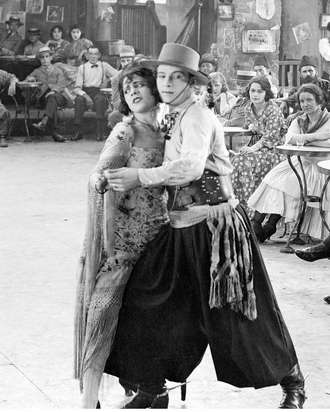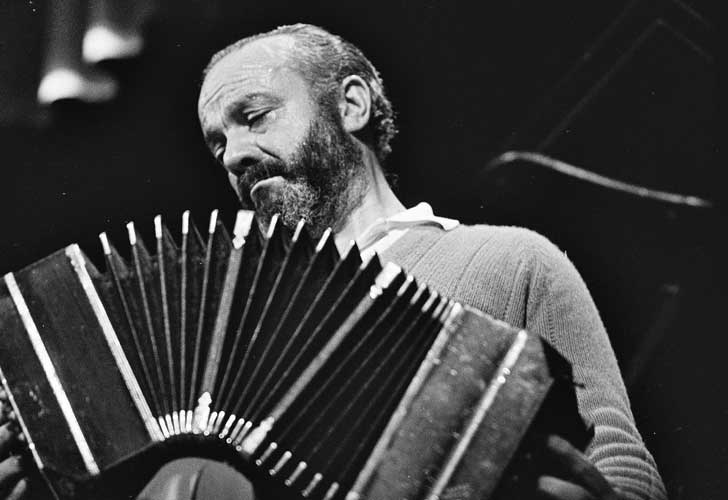The Story Of The Argentine Tango
The Story Of The Argentine Tango
A look at the history of Tango, past, present, and future and it's most influential figures.

The history of Argentine tango is essentially the history of Buenos Aires. The two are synonymous and intrinsic to the existence of the other.
Tango found its way to America after the success of a the 1926 film "The Four Horsemen of the Apocalypse" starring Argentinian actor Rudolph Valentino.
He performs the most infamous tango scenes ever displayed on the silver screen, as he dances in his gaucho chaps with a carnation in his mouth. The irony here though is that gauchos (Argentinian cowboys) actually never dance tango--ever. But the strong impression and immortality of that scene means that it is forever entangled with the tango.
performs the most infamous tango scenes ever displayed on the silver screen, as he dances in his gaucho chaps with a carnation in his mouth. The irony here though is that gauchos (Argentinian cowboys) actually never dance tango--ever. But the strong impression and immortality of that scene means that it is forever entangled with the tango.
One of the most defining characteristics of the tango is the music, known by the same name. Tango music is distinctive to the ear, characterized by melancholy undertones created by an instrument called the bandoneon. The bandoneon is similar to the accordion and comes from Germany. Eduard Arolas is the man who is deemed to be the father of tango music, having been one of the first people to embrace the instrument and weave it into the music.
The two best-known tango musicians who helped shape the art form into what it is today are Carlos Gardel and Astor Piazzolla. Gardel was a French Argentine singer and composer that brought the music of tango to new heights and is solidified as one of the most prominent figures in the art's history. Gardel died tragically in a plan crash at the age of 44 on his way to Colombia. His death was mourned across Latin America.

Piazzolla came after Gardel and is credited with laying the foundation that allowed for the eventual evolution of the tango into what it is today. The traditional use of only standard violins and bass was mixed with synthesizers and electric guitars to create a more rock-influenced tango.
The Beginnings
Tango is know as an elegant dance glamorized by high society, but what many don't know is that the dance did not originate among the upper class. Instead, it was founded among the prostitutes and lower-class underside of Argentinian society. Tango is said to have been birthed around the 1880s, and its movements are believed to be inspired by the relationship at that time between a prostitute and her pimp.The Spread
As one can imagine, this form of "obscenity" was not popular among higher society in 1880s Argentina. But despite the dance's lewd heritage, it spread along the underbelly of Argentine society until it was one day observed by Ricardo Guiraldes, an Argentinian high-born playboy who enjoyed mingling with the more artistic, free-spirited parts of Argentine society. As a poet, Guiraldes took a trip to Paris, France, where he wrote a poem in honor or the tango and performed the dance for a Parisian audience. This was the beginning of Europe's embrace of Latin American dances, and to this day, Europe's love of Latin-style dance remains.Tango found its way to America after the success of a the 1926 film "The Four Horsemen of the Apocalypse" starring Argentinian actor Rudolph Valentino.
He
 performs the most infamous tango scenes ever displayed on the silver screen, as he dances in his gaucho chaps with a carnation in his mouth. The irony here though is that gauchos (Argentinian cowboys) actually never dance tango--ever. But the strong impression and immortality of that scene means that it is forever entangled with the tango.
performs the most infamous tango scenes ever displayed on the silver screen, as he dances in his gaucho chaps with a carnation in his mouth. The irony here though is that gauchos (Argentinian cowboys) actually never dance tango--ever. But the strong impression and immortality of that scene means that it is forever entangled with the tango. One of the most defining characteristics of the tango is the music, known by the same name. Tango music is distinctive to the ear, characterized by melancholy undertones created by an instrument called the bandoneon. The bandoneon is similar to the accordion and comes from Germany. Eduard Arolas is the man who is deemed to be the father of tango music, having been one of the first people to embrace the instrument and weave it into the music.
The two best-known tango musicians who helped shape the art form into what it is today are Carlos Gardel and Astor Piazzolla. Gardel was a French Argentine singer and composer that brought the music of tango to new heights and is solidified as one of the most prominent figures in the art's history. Gardel died tragically in a plan crash at the age of 44 on his way to Colombia. His death was mourned across Latin America.

Piazzolla came after Gardel and is credited with laying the foundation that allowed for the eventual evolution of the tango into what it is today. The traditional use of only standard violins and bass was mixed with synthesizers and electric guitars to create a more rock-influenced tango.